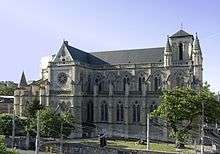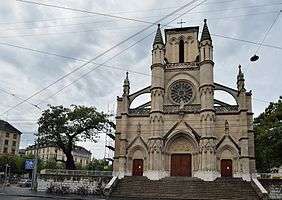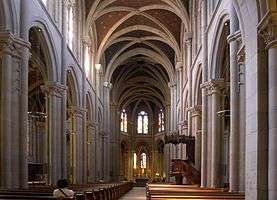Basilica of Our Lady of Geneva
The Basilica Notre-Dame of Geneva is the main Roman Catholic church in Geneva, Switzerland, the old Saint-Pierre cathedral being now a Protestant parish.[1][2]
| Basilica of Our Lady of Geneva | |
|---|---|
Basilique Notre-Dame de Genève Basilika Unserer Lieben Frau von Genf | |
 Basilica of Our Lady of Geneva | |
 Basilica of Our Lady of Geneva Location of Our Lady of Geneva in Switzerland | |
| Country | Switzerland |
| Denomination | Roman Catholic |
| Website | Basilica of Our Lady of Geneva |
| History | |
| Status | Minor Basilica |
| Founded | 1852-1857 |
| Architecture | |
| Functional status | Active |
| Heritage designation | Swiss Inventory of Cultural Property of National and Regional Significance |
| Style | Gothic |
| Administration | |
| Diocese | Roman Catholic Diocese of Geneva |
The statue of Our Lady of Geneva, offered by the Pope Pius IX, is venerated. It is also a stopover for pilgrims going to Santiago de Compostela. The basilica marks somehow the beginning of the via Gebennensis, which extends from Le Puy-en-Velay in via Podiensis.
The motto of Our Lady of Geneva is Nuntia Pacis, Latin for Peace Messenger.

History

The church was built according to the design of Alexandre Grigny between 1852 and 1857 on the site of a former stronghold fortifications. This neo-Gothic building, whose appearance is partly inspired by the Beauvais Cathedral, could break ground thanks to the city of Geneva, which had ceded land to religious communities to build places of worship, and through donations and manual labor provided by the Geneva Catholics.
The dedication is celebrated October 4, 1857. Father Gaspard Mermillod, future episcopal vicar of Geneva then cardinal pronounced the sermon. He was later expelled from Switzerland by the government.
After the coming to power of an anti-clerical government, Notre Dame is occupied on June 5, 1875 and closed. This occupation is accompanied by a protest against the Roman Catholic and more unrests. The commitment of Catholics to this sanctuary becomes even greater. Notre-Dame was bought by the Catholic Church in 1911–1912.
On December 5, 1954, Bishop François Charrière, diocesan bishop, pronounced in the name of Pope Pius XII the elevation of the shrine to the rank of "minor basilica".
Heritage
The oldest art works of the basilica date back to the time immediately preceding the Protestant Reformation:
- a torch, decorated with paintings, belonging to a convent deleted during the Protestant Reformation;
- a carved wood panel with bas-relief image of the Virgin Mary, mutilated with an ax by Protestants.
Other works or art objects are the object or through the worship the statue of Our Lady of Geneva, the tabernacle and the carved liturgical furniture (altar, ambo, clams).
The stained glass windows of the basilica are particularly remarkable. Some are semi-industrial production neo-gothic, but most show the evolution of the art of stained glass during the twentieth century, in various styles, after those of Claudius Lavergne (installed from 1857 to 1875). From 1912, several artists have successively contributed to adorn the basilica: Charles Brunner, Alexandre Cingria, Maurice Denis, Gherri Moro, Paul Monnier, Jean-Claude Morend, Théodore Strawinsky. The building is classified as Cultural Property of National Significance.
Stained glass windows
 Top: God the Father; middle: Dove of Holy Spirit in trefoil; lower: Annunciation scene.
Top: God the Father; middle: Dove of Holy Spirit in trefoil; lower: Annunciation scene.












References
- "La Basilique Notre-Dame de Genève" (in French). Société d'histoire de l'art en Suisse. Retrieved 8 May 2015.
- "Genève (église Notre-Dame" (in French). Orgues & vitraux. Archived from the original on 3 March 2016. Retrieved 9 May 2015.
External links
| Wikimedia Commons has media related to Notre-Dame basilica in Geneva. |